Family: Lamiaceae (mint)
Parts Used: leaves and flowers
This plant is indigenous to North America and is best known for its ability to control nervous irritation. For this purpose, it is used in many nervous system formulas including pain and sleep issues.
Properties and Herbal Actions:
- nervine
- antibacterial
- antispasmodic
- sedative nervine
- diuretic
- bitter
- cooling
- drying
Uses:
- Supports the nerves, quieting and strengthening the nervous system.
- Nervous tension and exhaustion, calms nerves, restlessness, panic attacks, emotional trauma, etc.
- Tranquilizing, opiate effect.
- Stress induced headaches.
- Pain relief, myalgia, neuralgia, shingles pain, herpes pain, nerve pain.
- Quiet mind and thoughts, aid the body in sleeping.
- Insomnia and anxiety relief.
- Aids in breaking addictions of all kinds, including pornography, and eases problems associated with withdrawal (1/2 cup tea, 2 capsules or 20 drops tincture every hour or two while symptoms subside).
- Muscle twitching, convulsions, tremors, epilepsy.
- Tetanus, rabies, and cholera.
Methods of Use:
- Tincture (don't use an alcohol tincture if treating for alcohol addiction and withdrawal) 30 drops per dose.
- Tea (1 teaspoon in 8 oz. water, steep for 20-30 minutes)
- Powder, capsules
- Liniment, massage oil
Growing/Wildcrafting/Harvesting:
You could also try to cultivate this plant, I have gotten seeds from Mountain Rose Herbs but haven't yet tried my hand at cultivation with them. Direct sow the seeds in the autumn or early spring or you can start indoors and transplant early spring. They prefer part shade to full sun.
- Gather leaves and blossoms while in bloom.
- Make a fresh tincture or dry quickly and keep in an airtight container in a cool area since it deteriorates rapidly from age and heat.
























